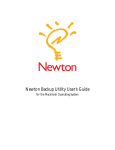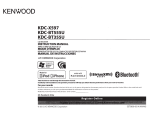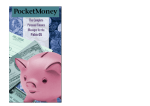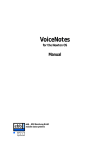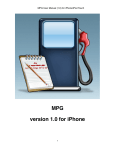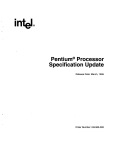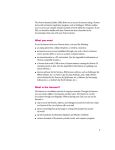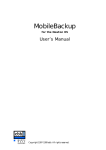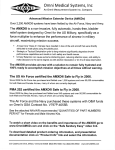Download PocketMoney User Manual ()
Transcript
PocketMoney™ User’s Manual DRAFT Version 2.0b8 April 6, 1995 PocketMoney User’s Guide @1996 Catamount Software. All rights reserved. Acknowledgments Software - Hardy Macia - Newton Toolkit Cover design - David Deranian - Photoshop Manual - Hardy Macia - Acrobat, ClarisWorks, and Canvas Manual layout - Terry Lane - QuarkXpress Editing - Computer Concepts And Methods and Kristine Chapman Printing - courtesy of the master printer in CA - one step printing Contact Information US Mail: Catamount Software PO Box 8276 Essex, VT 05451, USA Phone: (802) 863-5256 email: [email protected] www: http://www.catamount.com Trademarks PocketMoney™, ExCHANGE™ and WildCat™ are trademarks of Catamount Software. PocketMoney User’s Manual 2 Newton is a trademark of Apple Computer, Inc., registered in the U.S. and other countries. MessagePad is a trademark of Apple Computer, Inc. Other product names mentioned in this manual may be trademarks or registered trademarks of their respective companies and are the sole property of their respective manufactures. PocketMoney User’s Manual 3 License Agreement 1. License. The application, demonstration, system and other software accompanying this License, whether on disk, in readonly memory, or by any other media (the "Software") and the related documentation are licensed to you by Catamount Software. You own the media on which the Software is recorded but Catamount Software and/or Catamount Software's Licenser(s) retain title to the Software and related documentation. This License allows you to use the Software on a single Newton Product (which, for the purposes of this License, shall mean a product bearing Apple's Newton logo), and make one copy of the Software in machine-readable form for backup purposes only. You must reproduce on such copy Catamount Software's copyright notice and any other proprietary legends that were on the original copy of the Software. You may also transfer all your license rights in the Software, the backup copy of the Software, the related documentation and a copy of this License to another party, provided the other party reads and agrees to accept the terms and conditions of this License. 2. Restrictions. The Software contains copyrighted material, trade secrets and other proprietary material and in order to protect them, you may not decompile, reverse engineer, disassemble or otherwise reduce the Software to a human-perceivable form. You may not modify, network, rent, lease, loan, distribute or create derivative works based upon the Software in whole or in part. 3. Termination. This License is effective until terminated. You may terminate this License at any time by destroying the Software and related documentation. This License will terminate immediately without notice from Catamount Software if you fail to comply with any provision of this License. Upon termination you must destroy the Software and related documentation. 4. Export Law Assurances. You agree and certify that neither the Software nor any other technical data received from Catamount Software, nor the direct product thereof, will be exported outside the United States except as authorized and as permitted by the laws and regulations of the United States. If the Software has been rightfully obtained by you outside of the United States, you agree that you will not re-export the Software nor any other technical data received from Catamount Software, nor the direct product thereof, except as permitted by the laws and regulations of the United States and the laws and regulations of the jurisdiction in which you obtained the Software. 5. Government End Users. If you are acquiring the Software on behalf of any unit or agency of the United States Government, the following provisions apply. The Government agrees: (i) if the Software is supplied to the Department of Defense (DoD), the Software is classified as "Commercial Computer Software" and the Government is acquiring only "restricted rights" in the Software and its documentation as that term is defined in Clause 252.227-7013(c)(1) of the DFARS; and (ii) if the Software is supplied to any unit or agency of the United States Government other than the DoD, the Government's rights in the Software and its documentation will be as defined in Clause 52.227-19(c)(2) of the FAR or, in the case of NASA, in Clause 18-52.227-86(d) of the NASA Supplement to the FAR. 6. Disk Warranty. Catamount Software warrants that the original disk(s) is(are) free from defects in material and workmanship, assuming normal use, for a period of ninety (90) days from date of purchase. If a defect in the disk occurs during this period, you may return your faulty disk to Catamount Software, along with a proof of purchase; Catamount Software will replace it free of charge. After 90 days, you may obtain a replacement by sending your defective disk and a check for $10 (add sales tax for residents of VT) to Catamount Software. 7. Disclaimer of Warranty on Software. You expressly acknowledge and agree that use of the Software is at your sole risk. The Software and related documentation are provided "AS IS" and without warranty of any kind and Catamount Software and Catamount Software's Licenser(s) (for the purposes of provisions 6 and 7, Catamount Software and Catamount Software's PocketMoney User’s Manual 4 Licenser(s) shall be collectively referred to as "Catamount Software") EXPRESSLY DISCLAIM ALL WARRANTIES, EXPRESS OR IMPLIED, INCLUDING, BUT NOT LIMITED TO, THE IMPLIED WARRANTIES OF MERCHANTABILITY AND FITNESS FOR A PARTICULAR PURPOSE. Catamount Software DOES NOT WARRANT THAT THE FUNCTIONS CONTAINED IN THE SOFTWARE WILL MEET YOUR REQUIREMENTS, OR THAT THE OPERATION OF THE SOFTWARE WILL BE UNINTERRUPTED OR ERROR-FREE, OR THAT DEFECTS IN THE SOFTWARE WILL BE CORRECTED. FURTHERMORE, Catamount Software DOES NOT WARRANT OR MAKE ANY REPRESENTATIONS REGARDING THE USE OR THE RESULTS OF THE USE OF THE SOFTWARE OR RELATED DOCUMENTATION IN TERMS OF THEIR CORRECTNESS, ACCURACY, RELIABILITY, OR OTHERWISE. NO ORAL OR WRITTEN INFORMATION OR ADVICE GIVEN BY Catamount Software OR AN AUTHORIZED REPRESENTATIVE OF Catamount Software SHALL CREATE A WARRANTY OR IN ANY WAY INCREASE THE SCOPE OF THIS WARRANTY. SHOULD THE SOFTWARE PROVE DEFECTIVE, YOU (AND NOT Catamount Software OR AN AUTHORIZED REPRESENTATIVE OF Catamount Software) ASSUME THE ENTIRE COST OF ALL NECESSARY SERVICING, REPAIR OR CORRECTION. SOME JURISDICTIONS DO NOT ALLOW THE EXCLUSION IF IMPLIED WARRANTIES, SO THE ABOVE EXCLUSION MAY NOT APPLY TO YOU. 8. Limitation of Liability. UNDER NO CIRCUMSTANCES INCLUDING NEGLIGENCE, SHALL Catamount Software BE LIABLE FOR ANY INCIDENTAL, SPECIAL OR CONSEQUENTIAL DAMAGES THAT RESULT FROM THE USE OR INABILITY TO USE THE SOFTWARE OR RELATED DOCUMENTATION, EVEN IF Catamount Software OR AN AUTHORIZED REPRESENTATIVE OF Catamount Software HAS BEEN ADVISED OF THE POSSIBILITY OF SUCH DAMAGES. SOME JURISDICTIONS DO NOT ALLOW THE LIMITATION OR EXCLUSION OF LIABILITY FOR INCIDENTAL OR CONSEQUENTIAL DAMAGES SO THE ABOVE LIMITATION OR EXCLUSION MAY NOT APPLY TO YOU. In no event shall Catamount Software's total liability to you for all damages, losses, and causes of action (whether in contract, tort (including negligence) or otherwise) exceed the amount paid by you for the Software. 9. Controlling Law and Severability. This License shall be governed by and construed in accordance with the laws of the United States and the State of Vermont, as applied to agreements entered into and to be performed entirely within Vermont between Vermont residents. If for any reason a court of competent jurisdiction finds any provision of this License, or portion thereof, to be unenforceable, that provision of the License shall be enforced to the maximum extent permissible so as to effect the intent of the parties, and the remainder of this License shall continue in full force and effect. 10. Complete Agreement . This License constitutes the entire agreement between the parties with respect to the use of the Software and related documentation, and supersedes all prior or contemporaneous understandings or agreements, written or oral, regarding such subject matter. No amendment to or modification of this License will be binding unless in writing and signed by a duly authorized representative of Catamount Software. PocketMoney User’s Manual 5 Table of Contents 1. Introduction .......1 Know your Newton .......2 What’s Included .......3 Installing PocketMoney .......8 2. Basics .......9 Opening PocketMoney on the Newton .......9 Accounts .......10 Transactions .......10 Data Entry Screen .......12 Overview .......17 Running Balance .......27 Finance Slip .......28 Standard Newton Functions .......29 Info Button .......30 Show Button .......31 File Folder Button .......32 PocketMoney User’s Manual 6 Action Envelope Button 3. Samples .......33 .......35 Starting Balance for Checking .......36 Starting Balance for Savings .......37 Transfer Transaction .......38 Withdrawal Transaction .......39 Deposit Transaction .......40 Transaction in Foreign Currency .......41 4. Features .......43 Date Editor .......43 List Editor .......45 Category Splits .......47 Preferences .......49 Accounts .......52 Creating an Account .......56 Deleting an Account .......56 On Screen Reports PocketMoney User’s Manual .......57 7 Filtered Balance .......57 Category .......58 Payee .......58 Account Balance .......59 Cleared Balance .......59 Custom Filters .......60 Reconciling Accounts .......63 Rolling Up Transactions .......64 Recompute Balances .......65 Standing/Repeating Transactions .......66 5. Desktop .......69 Import and Export Formats .......70 Exchanging Data .......71 ExCHANGE .......72 WildCat .......73 Terminal Emulator .......75 PocketMoney User’s Manual 8 Chapter 1 - Introduction Thank you for purchasing the powerhouse of Newton finance programs– PocketMoney. PocketMoney was designed to one thing and do it very well— track your finances quickly with the smallest amount of work. PocketMoney tracks finances for you, but you might have other Newton programs that do things better than PocketMoney can— like tracking upcoming bills (Bills To Pay), tracking business expenses (ExpensePlus), calculating the tip at restaurants (CheckPlease), or tracking car expenses (MPG). Why are we talking abut other programs? Well these programs handle your money, too— like the $20 you spent on gas to fill up your Range Rover. MPG will figure out your Range Rover is only getting 14 miles per gallon and that you put $1000 worth of fuel in it for the year, but you shouldn’t have to enter the $20 into your finance program again...so MPG and PocketMoney work together to track your finances quickly with the smallest amount of work. PocketMoney has an open standard that the above programs support which allows MPG to save that $20 gas purchase to PocketMoney with just two taps of the stylus. PocketMoney has a few reports which most users will find adequate, but for the financial power users PocketMoney also gives you a way to create complicated financial reports. For this task PocketMoney lets you export to your desktop finance program, spreadsheet or database. With ExCHANGE and WildCat, you can upload PocketMoney data to most desktop applications, and from the desktop create the color graphs, P&Ls, balance sheets, cash flow reports, and integrated QuickTime movies of your dreams. PocketMoney User’s Manual 9 Know your Newton This manual assumes that you are already familiar with basic Newton operation including: • Writing and editing. • Accessing and using the keyboard. • The Extras drawer. • The Arrows and Dot. • ♦ The Diamond popup feature. • • • The Close box. The Assist button. Setting up printers. If not, consult your Newton MessagePad Handbook before you proceed. PocketMoney User’s Manual 10 What’s Included You will find the following files on the PocketMoney disk: NOTE: DOS filenames are in parenthesis after the Macintosh filenames. • PocketMoney.pkg (PM.PKG) - is the main PocketMoney package. PocketMoney User’s Manual 11 • README.TXT - contains late-breaking information on this version of PocketMoney. • Newton Package Installer (NPI.EXE) - use to install PocketMoney onto the Newton device if you have the appropriate cables. • Plug-ins - are separate packages that add optional functionality to PocketMoney. Load only those that you need to minimize memory requirements. • Reports - are separate packages that add optional printing functionality to PocketMoney. Load only those that you need to minimize memory requirements. NOTE: Some plug-ins only work on Newton OS 1.x and 2.0, some only on Newton OS 1.x, and some only on Newton OS 2.0. If a plug-in has the same name in the NOS 1.x folder as the NOS 2.0 folder then install the plug-in from the folder corresponding to your Newton’s OS. The plug-ins included on the PocketMoney disk are: Plugs that work on and : • IA(nodate).pkg (IANODATE.PKG) - provides Intelligent Assistant support. Refer to “Standing/Repeating Transactions” for information on using Assist with PocketMoney. • IA(w/date).pkg (IADATE.PKG) - provides Intelligent Assistant support for PocketMoney. IA(w/date) allows you to specify a date in your Assist phrase. Refer to “Standing/Repeating Transactions” for information on using Assist with PocketMoney. • NotifyAssist.pkg (NTFYASST.PKG) - written by Bill Kearney allows system alarms to be processed by the Intelligent Assistant. When the Alarms/System dialog box appears, tap the Assist button to interpret the dialog text as a PocketMoney transaction. Refer to “Using NotifyAssist” for further information. • IGOR.pkg - patches the Assist button to bypass the Intelligent Assistant. IGOR will speed the processing of Intelligent Assistant phrases and allow longer phrases for programs registered with IGOR. IA(nodate).pkg and IA(w/date).pkg take advantage of IGOR if IGOR is installed. PocketMoney User’s Manual 12 Plug-ins that only work on NOS 1.x: • ScrollingDoPopup.pkg (SDP.PKG) - allows you to scroll popup lists that are longer than the length of the screen, giving you an unlimited number of accounts, categories, and payees. When the list is longer than the screen, an arrow button appears as the last item on the list. Tap the arrow to show the next page of items. • Notepad Button.pkg (NOTEBUTT.PKG) - installs a PocketMoney button in the Notepad status bar. Tap the button to open a Data Entry Slip for PocketMoney. Hold down the button for half a second to show your account balances. Plug-ins that only work on NOS 2.0: • Notepad Button.pkg (NOTEBUTT.PKG) - installs a PocketMoney button in the Notepad status bar. Tap the button to open a Data Entry Slip for PocketMoney. Hold down the button for half a second to show your account balances. • Names Button.pkg (NAMEBUTT.PKG) - installs a PocketMoney button in the Names status bar. Tap the button to open a Data Entry Slip for PocketMoney. The payee is filled in based on the current Name card. • ScrollMenus.pkg (SCRLMENU.PKG) - written by Stand Alone, Inc. makes the popup menus scroll a page at a time. The default scroll value in Newton OS 2.0 is an item at a time. The Reports included on the PocketMoney disk are: • Payee.pkg - adds an item to the print, fax, and email dialogs of PocketMoney, giving you access to a Payee Report. Refer to “Sending PocketMoney Data” for further information. • Category.pkg - adds an item to the print, fax, and email dialogs of PocketMoney, giving you access to a Category Report. Refer to “Sending PocketMoney Data” for further information. PocketMoney User’s Manual 13 • Account.pkg - adds an item to the print, fax, and email dialogs of PocketMoney, giving you access to an Account Report. Refer to “Sending PocketMoney Data” for further information. • Personal Check.pkg (PERSCHK.PKG) - adds an item to the print and fax dialogs of PocketMoney allowing you to print the current transaction onto a personal sized check. Refer to “Sending PocketMoney Data” for further information. • Business Check.pkg (BUSCHK.PKG) - adds an item to the print and fax dialogs of PocketMoney allowing you to print the current transaction onto a business sized check. Refer to “Sending PocketMoney Data” for further information. PocketMoney User’s Manual 14 Installing PocketMoney To install the PocketMoney package onto your Newton you need the Newton Package Installer, Newton Backup Utility, or the equivalent software. Refer to the documentation that came with your Newton PDA for instructions on installing Newton software. The minimum recommended packages to install are PM.pkg and Notepad Button.pkg. Plug-ins and Reports are extensions. Extensions are filed in the Extension folder using OS 2.0 and are invisible using PocketMoney User’s Manual Newton Newton OS 1.x. 15 Chapter 2 - Basics This chapter covers basic PocketMoney transaction operations and screens. Refer to “PocketMoney Features” for full coverage of all of PocketMoney’s features. Opening PocketMoney on the Newton To access PocketMoney, simply: • Tap Extras then tap PocketMoney. NOTE: The PocketMoney Account Prefs screen will appear the first time. Accounts PocketMoney provides five accounts to get you started - Checking, Savings, Credit Card, Pocket (Cash), and American Airlines (frequent flyer miles). You may create additional accounts as needed in the Account Prefs screen (See Chapter 4). Accounts that represent your assets (checking, savings, and pocket) normally have a positive balance. Accounts that represent liabilities (i.e., money you owe), such as credit cards, normally have a negative balance, until you pay them off. With this representation, a calculation of your net worth, for example, would simply be a sum of the balances in all the accounts. Transactions PocketMoney provides three types of transactions using the Data Entry Slip: • Deposit - from sources outside PocketMoney. Deposits are any transactions that increase your net worth, such as depositing your paycheck into checking, or depositing an inheritance from Aunt Gertrude in your savings account. • Withdrawal - to payees outside PocketMoney. Withdrawals are any transactions that decrease your net worth, such as writing a check for your electric bill, spending $10 at the movies, or using your credit card to purchase a new snowboard. PocketMoney User’s Manual 16 • Transfer - from one PocketMoney account to another. Transfers do not change your net worth because money is just being moved between accounts. Examples include withdrawing cash with your ATM card, or writing a check to pay your credit card. NOTE: Transfer transactions are saved as two separate entries; one transaction for the transfer from account and one transaction for the transfer to account. Any modifications made to one half of the transfer are made to the second half.) PocketMoney User’s Manual 17 Data Entry Screen The Data Entry Screen looks similar to this for Deposit, Withdrawal, and Transfer transactions: It includes the following elements: • Folder - the Newton folder that the current transaction (deposit) is filed in. By default, this is the folder called All PocketMoney Items. HINT: You can use folders to keep your personal finances separate from your business finance for expense reporting. Folders are exported as Quicken classes. • Transaction Type - either Deposit, Withdrawal, or Transfer. This field is not editable. • Date - the date that the transaction took place. You may choose to display the date alone or the date and time using the PocketMoney Preferences. The date and time must be in the format “June 16, 1994 2:35 am”. Tap on the ♦ Date label to popup the Date Editor. • Account - the name of the account that you are tracking (e.g., checking, credit card, or any other one that you have created). Tap on the ♦ Account label to select an account for the transaction or to access the List Editor. PocketMoney User’s Manual 18 • Category - allows you to organize your transactions into categories such as Salary or Interest. Tap on the ♦ Category label to select a category for the transaction or to access the List Editor. Refer to “Category Splits” for further information. • Payee (To/From/Trans To/Trans From) - generally referred to as the Payee field; this label is based on the transaction type. “To” is displayed for Withdrawal, “From” is displayed for Deposit, “Trans To” and “Trans From” are displayed for Transfer. Write or key in a name or tap on the ♦ label to popup the List Editor to choose a pre-defined source for the transaction or to add a new source. The popup list of choices is dependant upon the Category. So, if Category is food, only places that you purchase food from are displayed. You must pick the Account to transfer to from the popup list for Transfers. This field is two lines so that long names can be entered. HINT: Activate “Automatically add payees to popup” in Prefs to save time editing the popup list. HINT: If you have problems writing here, try writing the words so that they straddle the first baseline. • Search Names Button - is a shortcut to entering name or company information that exists in Names. is not displayed for Transfers. Newton OS 1.x– allows you to search the Name file as you would from the Newton telephone call slip. After you enter part of the name, tap to perform the search. If names are found, ♦ changes to ◊ indicating the popup list now contains the items found in the search. Newton OS 2.0– tapping opens the Newton People Picker. Checking the names or companies and tapping the close box will enter the selected information into the Payee field. PocketMoney User’s Manual 19 • Search PocketMoney Button - searches your PocketMoney data until it finds a partial match for what you entered on the Payee line. If a match is found, the Account, Category, From, Amount, and Notes from the match are copied into the current transaction. For example, if you enter “sto” and tap —the search you might find “stock dividends”. Use this feature to handle repetitive transactions like a paycheck deposit. • Amount - the amount of the transaction. Tap the ♦ label to pick from some common ATM withdrawal amounts. Edit this list to suit your needs with the List Editor. • Rate - the foreign currency exchange rate. Rate is displayed if Multiple Currencies is checked in Prefs (Refer to Chapter 4; Preferences). Enter Amount and the current exchange rate corresponding to 1 unit of your based currency. If you receive a $20 Canadian payment then you enter $20 in Amount and enter 1.33 in Rate. 1.33 Canadian dollars is equal to 1 US dollar. Tap ♦Rate to open the Exchange Worksheet. NOTE: The exchange rate is saved on a transaction by transaction basis. This allows you to edit the rate after you receive your credit card statement to reflect the actual exchange rate that your credit card company used. • Id # - check number or any other identifier you wish in this field. The popup list gives you two options: New Check # - PocketMoney searches old entries to find the next available check number. If you wish to put ATM transaction numbers into the Id # field, you should prefix the number with ATM or some other text to distinguish non-check numbers from check numbers. PocketMoney User’s Manual 20 Include Fee - PocketMoney adds a separate transaction for the default fee set by the user in Account Prefs(see Accounts Prefs in Chapter 4). No fee transaction is added if the default fee amount value is 0 or blank. • Cleared - a check in this box your bank statement. • Balance - the balance of the account, after the transaction is made. Tap on the ♦ Balance label to change the display setting. The choices are Balance, Cleared Balance, and Demo Mode. means that the transaction has cleared the bank. Use this to reconcile HINT: Demo Mode will display all amounts as $xxx.xx so you can safely demonstrate PocketMoney to others without revealing your financial information. • Notes - several lines of additional information of your choice about the transaction. PocketMoney User’s Manual 21 The Overview Screen The Overview screen provides a list of all transactions. Overview is the easiest way for a quick look at all your data, for fast access to a specific transaction, and for clearing a large number of transactions quickly. Accessing the Overview Screen To access the Overview Screen tap the overview dot. There are four choices for format. Two Line: Two Line with Balance: Single Line with ID: Single Line: PocketMoney User’s Manual 22 Accessing a particular Data Entry Slip To access the corresponding Data Entry Slip from the Overview Screen, simply tap the desired transaction. NOTE: There are two overview items for each transfer transaction. Check Box Tap the check box to mark a transaction as cleared or uncleared . Running Balances The “Two Line w/Balance” overview displays the running balance in the Balance column. This overview format is similar to how your checkbook looks when you manual keep track of your accounts. The balance at the time the transactions was made is referred to as the running balance. The “Two Line w/Balance” overview must recalculate all balances defined by the current filter— this can take a long time if you have a lot of data. You can speed up viewing the overview by rolling up your data (refer to “Rolling Up Transactions”). Only use the “Two Line w/Balance” overview feature when necessary. PocketMoney User’s Manual 23 If you are using PocketMoney with Newton OS 2.0 system then setting a filter on a single account will speed the overview. PocketMoney User’s Manual 24 Finance Slip The Data Entry Slip opens if PocketMoney receives a posting from another program and PocketMoney decides there is missing data. For instance, if a transaction is posted from CheckPlease 3.0, the account and payee will be missing. Fill in the missing information and then tap PocketMoney User’s Manual . 25 Standard Newton Functions The standard Newton functions interact with PocketMoney as follows: Scroll Up and Down Arrows The Up and Down arrows scroll to the next or previous transaction when in the Data Entry Slip view. When in the Overview, the Up and Down arrows scroll a full or half screen of entries depending on the Prefs setting. If it is not possible to scroll any further in the desired direction, a beep sounds. Overview Dot Also known as the Belly Button, this button toggles the screen between the Overview Screen and the Data Entry Slips. Find The Find button allows you to search for any text in the PocketMoney soup. The Find button is a good way to find transactions that you do not remember the date on which the transaction was made. NOTE: The only items you cannot find in this manner are Amounts. Amounts are stored as real numbers and cannot be searched. Refer to your Newton MessagePad Handbook for more information. PocketMoney User’s Manual 26 Info Button The Info button popup has a list of choices that show additional PocketMoney information. • About - displays a screen with the version of PocketMoney and technical support contact information. • Prefs - opens the PocketMoney Preferences screen, allowing you to change the default behavior of some features. Refer to “PocketMoney Preferences” for further information. • Accounts - allows you to store information and preferences for each account. Refer to “Account Preferences” for further information. • Filtered Balance - opens the filtered balance screen, which sums up the transaction amounts based on the current filter setting. Refer to “PocketMoney Reports” and “Filters” for further information. • Category Expenses - generates a report listing amounts spent by category. • Payee Expenses - generates a report listing the amounts paid per Payee. • Account Balances - opens the account balances screen, which shows your account balances and your total worth. Refer to “PocketMoney Reports” for further information. PocketMoney User’s Manual 27 • Cleared Balances - opens the cleared balance screen, which shows the reconciled account balances and total. Refer to “PocketMoney Reports” for further information. PocketMoney User’s Manual 28 Show Button The popup has a list of filters that are available for selectively displaying transactions. Some filters are provided by PocketMoney and others can be customized. Tap on the desired filter or tap Custom to create a new filter. Refer to “Custom Filters” for further information on creating filters. • All Items - resets the filter to show all transactions. • Item at Date - positions to the date you specify in the Date Editor. • First Item - positions to the earliest dated transaction. • Last Item - positions to the latest dated transaction. PocketMoney User’s Manual 29 File Folder Button PocketMoney supports standard Newton filing. NOTE: PocketMoney exports filed items as classes in Quicken. Refer to Quicken for more information about classes. To file a transaction: 1. Display the desired transaction in a Data Entry Slip. 2. Tap 3. Tap the appropriate folder. . Refer to your Newton MessagePad Handbook for more information about filing. PocketMoney User’s Manual 30 Action Envelope Button The Action Envelope popup supports the following functions: Sending PocketMoney Data The Action Envelope button allows access to the following standard Newton output mechanism for the Data Entry Slip, Overview Screen, and various Reports: • Print - Prints the item or transaction sheet on your printer. Expand printing by installing additional Reports. • Fax - Fax the item or transaction sheet via fax/modem. Expand faxing by installing additional Reports. • Beam - Beams the item to another Newton . PocketMoney User’s Manual 31 • Mail - E-mail an item or transaction sheet. This is also useful if you want to copy the text version of the item to the Notepad. Expand e-mail by installing additional Reports. PocketMoney Data Maintenance The data: Action Envelope button includes several functions related to maintenance of PocketMoney • Reconcile Account - allows you to reconcile the balance of cleared transactions against a bank or credit card balance. Refer to “Reconciling Account” for further details. • Rollup Items - used in conjunction with a filter, rolls up selected transactions into a single transactions. Refer to “Rolling Up Transactions” for more information on how to use this in conjunction with a desktop application. • Recompute Balances - recalculates all your account balances if you modify your PocketMoney data via the Newton Connection Kit. Refer to “Recompute Balances” for further information. • Delete - deletes the current transaction on the Data Entry Slip. • Duplicate - makes a copy the current transaction on the Data Entry Slip. • Move to/from card - moves a transaction item to or from the storage card. NOTE: This is a Newton OS 1.x feature. Newton OS 2.0 uses the Filing button to move items to and from a storage card. PocketMoney User’s Manual 32 Chapter 3 - Samples Initially, all account balances in PocketMoney are zero. The first step in PocketMoney is creating Opening/Starting balances for all your accounts. Let’s set up balances for the Checking and Visa accounts. These accounts are the defaults built into PocketMoney, but you can change the name of the accounts and add as many other accounts as you need. PocketMoney User’s Manual 33 Starting Balance for Checking Let’s create a checking account starting balance of $354.88: 1. Tap . 2. Select 3. If the Account listed is not Checking, tap on the ♦ Account label and select Checking. 4. Leave the category blank. 5. Write or key “Opening Balance” into the From field. 6. Write or key the check number of the last check that you wrote into the Id # field. This enables PocketMoney to assign the next available check number. 7. Write or key 354.88 into the Amount field. 8. Observe that the calculated balance is $354.88 ( Newton OS 1.x will not have an icon). PocketMoney User’s Manual 34 Starting Balance for Visa Let’s create an unpaid balance in your Visa account of $1,224.69: 1. Tap . 2. Select 3. Tap on the ♦ Account label and select Visa. 4. Leave the category blank. 5. Write or key “Opening Balance” into the To field. 6. Write or key 1224.69 into the Amount field. 7. Observe that the calculated balance is minus $1,224.69. Credit card balances are liabilities against your net worth. . This is money you owe. PocketMoney User’s Manual 35 Transfer Transaction Let’s enter data for a check to pay your credit card bill: 1. Tap . 2. Select 3. If the Account name does not appear as Checking, tap on the ♦ Account label and then tap Checking. 4. Leave the Category blank. 5. Tap on the ♦ Trans To label and then tap Visa. 6. Tap on the ♦ Id # label and then tap Next Check #. The next available number appears here. Alternatively, you can write in or key in a check number. 7. Write or key the amount of the check into the Amount field. 8. Observe that the calculated balance has been updated to reflect the new check. . PocketMoney User’s Manual 36 Withdrawal Transaction Let’s enter data for a credit card purchase: 1. Tap . 2. Select 3. Tap on the ♦ Account label and select Visa. The balance at this point reflects the opening balance and the payment that you entered in the examples above. 4. Tap on the ♦ Category label and select the appropriate category (e.g., Recreation). 5. Write or key the name of the store (e.g., Smuggler’s Notch Ski Shop) into the To field. 6. Write or key the amount of the purchase into the Amount field. 7. Observe that the calculated balance has been updated to reflect the new purchase. 8. Optional: Enter information in the Notes field (e.g., Snowboard). . PocketMoney User’s Manual 37 Deposit Transaction Let’s enter data for a paycheck deposit: 1. Tap . 2. Select 3. If the Account name does not appear as Checking, tap on the ♦ Account label and select Checking. 4. Tap on the ♦ Category label and select Salary. 5. Write or key the name of your employer (e.g., E. Scrooge) into the From field. The next time you enter a paycheck you can use the Search PocketMoney or Search Name feature to copy this transaction. 6. Write or key the amount of the paycheck into the Amount field. 7. Observe that the calculated balance has been updated to reflect the new deposit. . PocketMoney User’s Manual 38 Transaction in Foreign Currency Let’s enter data for a credit card purchase in a foreign country: 1. Turn on Multiple Currencies in the Prefs screen. 2. Tap 3. Select 4. Tap on the ♦ Account label and select Visa. The balance at this point reflects the opening balance and the payment that you entered in the examples above. 5. Tap on the ♦ Category label and select Food. 6. Write or key the name of the restaurant into the To field. 7. Write or key the amount (in foreign currency) of the purchase into the Amount field. 8. Enter the current exchange rate in the Rate field. For example, if 1.33 is the current exchange rate between Canada and the US then 1.33 Canadian dollars (foreign currency) equals 1 US dollar (base currency for account) . 9. Observe that the calculated balance has been updated to reflect the new purchase. . . PocketMoney User’s Manual 39 Chapter 4 - Features Chapter 2 covered basic transaction entry and navigation. This chapter covers all the other features of PocketMoney. PocketMoney User’s Manual 40 Date Editor PocketMoney automatically enters the current Date and Time as set in your Newton for each new transaction you enter. However, if you are a few days behind in recording transactions, or you realize you have made a mistake, you may change the date and time for any transaction you wish. The PocketMoney Date Editor is similar to the Date and Time preference in the Newton Preferences. • Tap to move the calendar to the previous month. • Tap to move the calendar to the next month. • Tap a Day on the calendar to select a new day. • Tap the outer clock circle to change the minutes on the clock. • Tap the inner clock circle to change the hours on the clock. • Tap to toggle between AM and PM. PocketMoney User’s Manual 41 • Tap • Tap to set the calendar and clock to the current day and time. to enter into the date field the date and time you have set in the Date Editor. • To close the Date Editor without saving the changes tap somewhere other than on the Date Editor. PocketMoney User’s Manual 42 List Editor The editable popup list is one of the outstanding features of PocketMoney. The editor is how you edit PocketMoney customizable popup lists. Use the List Editor as follows: • Select Edit in the popup list to bring up the List Editor so that you may add, change or remove list items. • To Add an Item to the List, write the item you wish to add on the Edit Me line. If the item is not found in the existing popup list, the Add button appears. Tap • to add the item to the list. To Change an Item, tap the ♦ Edit Me label and select the item you wish to change. Write in the new name on the Change To line or select an existing item from the ♦Change To popup. Tap . For the Account and Category popups every occurrence of the old item is changed to the new item, but for the Amount, ID, and Payee popups the popup is changed and the data is not. The new item is also added to the popup list. PocketMoney User’s Manual 43 • To Remove an Item from the List, tap the ♦ Edit Me label, select a name, and tap the item from the list. to remove Newton OS 1.x– if your popup lists are longer than the screen and you cannot access the Edit option then install the ScrollingDoPopup.pkg plug-in. Refer to “What's Included with PocketMoney” for further information. PocketMoney User’s Manual 44 Category Splits The category popup has a choice called <--Splits-->: Select <--Splits--> to activate the Splits screen: PocketMoney User’s Manual 45 Splits allow entry of multiple categories with varying amounts for a single transaction. The total amount over all split categories is automatically added up, and, if there is not already a transaction amount, this total is copied to the Data Entry Slip amount. NOTE: If you do not specify an amount for the last split item then the remaining balance is entered as the amount for the last split category if it does not have a balance. Clear Splits will remove all of the splits entered for this transaction. PocketMoney User’s Manual 46 Preferences The PocketMoney Preferences screen allows you to set default values and behaviors based on the way you prefer to work: It includes the following items: • Home Currency - defines the default currency that all new accounts use. It also is the currency format used to calculate the Total Worth. Tap the ♦ Home Currency to change the default currency. • Multiple currencies - specifies use of multiple currencies. Check the check box to allow the use of multiple currencies. PocketMoney User’s Manual 47 • Defaults for New Entries - supplies a default value for the Account and Category values supplied automatically for a new transaction. Tap the ♦ Account label or ♦ Category label and then tap the desired default. • Show Date Only (no time) - determines whether the Data Entry Slip shows the date only in the date field or the date and time. Check the check box to only show the Date. • Scroll full page in the Overview - determines whether the Overview Screen scrolls a full page of entries (minus one) or a half a page of entries at a time. Check the check box to scroll a full page of entries (minus one) in the overview. • New entries use same date as Current Entry - determines the default value for the date on the Data Entry Slip. Tap the check box to use the same date as on the most recently displayed transaction for the new entry. • Show Account Balances when Opening - determines what is displayed when PocketMoney first opens. Check the check box to display the Account Balances screen when PocketMoney opens. • Reconstruct popups during Recompute Balance - determines if the Recompute Balance function performs data validation, category popup reconstruction and account popup reconstruction. Check the checkbox if you wish to recalculates cleared and absolute balances, add all accounts to the Account popup, add all categories to the Category popup, add all payees to the Payee popup based on the category, and performs data validation on transactions and preferences. Uncheck the checkbox if you wish to only recalculates the cleared and absolute balances. • Automatically add payees to popup - determines the behavior of the payee popup. Check the check box to add any new payee to the Payee popup. Payee popup includes To and From popups. • Password - accepts an optional password for those of you who wish a password for PocketMoney. Write in your desired password here and the next time PocketMoney runs you will be prompted for the password. If you wish to eliminate the password later, simply erase it here. The Password screen does not activate if PocketMoney is the background application. PocketMoney User’s Manual 48 Account Prefs The Account Prefs screen allows you to supply detailed information about particular accounts and set default values and behaviors for those accounts. It includes the following data items: • Account - allows you to select the account you wish to define. Tap the ♦ Account label and then tap the desired account. • Type - allows you to define a particular type of account, such as bank, cash, credit card or frequent flyer. Tap the ♦ Account Type label and then tap the desired type. PocketMoney User’s Manual 49 • exp - is displayed when Type is Credit Card. This allows you to write in an expiration date for your credit card for reference . Tap the ♦ exp label and then tap the desired date. • Account # - allows you to write in an account number for reference. • Institution - allows you to write in the name of the institution who issued the account, for reference. • Phone # - allows you to write in a phone number for the institution, for reference. Tapping the phone icon will open the call slip. • Exchange Rate - displays the exchange rate and currency format for the selected account. Tapping it opens the Currency & Conversion Rate editor. Prefix - is the symbol that appears before the amount. Suffix - is the symbol that appears after the amount. Decimal Places - specifies the number of decimal places in the currency. For example Japanese Yen have zero decimal places. Rate - is the amount of this currency that is equal to 1 unit of the Base Currency. Base Currency is set in Prefs. • Transaction fee - accepts a numeric value to use in conjunction with the Include Fee option on the Data Entry Slip Id # field. Write in a value or tap the ♦ Transaction fee label to access a popup list of choices. PocketMoney User’s Manual 50 • Fixed or Percent - determines how the Transaction Fee is applied. Tap the ♦ fixed label or ♦ percent label to indicate if the Transaction Fee is to be applied as a fixed value added to the transaction amount or as a percent of the transaction amount. For example, 1.00 as a fixed amount means one dollar. 1.00 as a percent amount means 1 percent. • Minimum Balance - accepts a numeric value to represent the account’s minimum balance requirements, if any. PocketMoney warns you if your balance ever falls below this amount. Write in a value or tap the ♦ Minimum Balance label to access a popup list of choices. • Credit Limit - accepts a numeric value to represent the account’s credit limit requirements, if any. PocketMoney warns you if your balance ever exceeds this amount. Leave Credit Limit blank if you do not want to be warned. Write in a value or tap the ♦ Credit Limit label to access a popup list of choices. • Include account in Total Worth calculation - determines whether this account’s balance is added to the Total Worth calculation in the Account Balance and the Cleared Balance screens. Check the check box to include this account in the Total Worth calculation. PocketMoney User’s Manual 51 Creating a New Account Tap to enter information for a new account. The following screen appears: Write in the name of the new account. When you tap prepared for the new account data. Close, the Account Preferences screen is Deleting an Account Tap the deletion. to delete all information for the displayed account. PocketMoney asks you to confirm NOTE: You must delete all transactions associated with this account before PocketMoney will allow you to delete it. PocketMoney User’s Manual 52 On Screen Reports The Info button provides access to PocketMoney reports that do not need to be printed out to be viewed.. Filtered Balance Report The Filtered Balance report sums up all transactions based on the current filter setting. This feature allows you to get a balance for a current set of data without having to switch Show Running Balances on and off in the Overview Screen. For example, if you set the category to Food, Filtered Balance gives the total that you have spent on food in all of your accounts. Refer to “Filters” for further information. Category Expenses Category Expenses displays the amount of money spent broken down by category. You can define the scope of the report by setting the filter. Payee Expenses Payee Expenses displays the amount of money spent broken down by payee. You can define the scope of the report by setting the filter. PocketMoney provides simple expense reporting tools. Catamount Software recommends ExpensePlus by PowerWare for a full featured expense programs for the Newton PDA. ExpensePlus can save transactions to PocketMoney ( thereby reducing double data entry) with the installation of the EPFPS.pkg plug-in. PocketMoney User’s Manual 53 Account Balances and Cleared Balance Reports The Account Balances Report lists each account with a balance not equal to zero and its current balance, along with your total net worth (sum of all accounts with * next to name). Refer to “Account Prefs” for further information on including accounts in the total net worth calculation. The Cleared Balances Report lists each account that has cleared transactions and its current balance of only those cleared transactions, along with the total of all cleared transactions in all * accounts. Tap to put a copy of the report in the Notepad. HINT: Tap and hold Notepad Button.pkg or Names Button.pkg for 1 second or until you hear a beep sound to access the Account Balance Report directly from the Notepad. PocketMoney User’s Manual 54 Custom Filters Filters are a powerful way to display and report on subsets of transactions. PocketMoney dynamically updates the views of the data represented by the currently chosen filter every time the Newton screen is redrawn. Tap and select Custom to display the Custom Filter screen: Pick which items you would like displayed: • Transaction - allows selection of Deposit, Withdrawal, Transfer, or All Transactions to include in the filter. Tap the ♦ Transaction label and select the desired transaction classification. • Account - allows selection of particular accounts to include in the filter. Tap the ♦ Account label and select the desired account. PocketMoney User’s Manual 55 • Category - allows selection of particular categories to include in the filter. Tap the ♦ Category label select tap the desired category. • To/From - allows selection of particular payees and sources to include in the filter. Tap the ♦ To/From label and select or write in the desired item. • Dates From - allows selection of a start date to include in the filter. Tap the ♦ Date From label to bring up the Date Editor. • Dates To - allows selection of ending date to include in the filter. Tap the ♦ Date To label to bring up the Date Editor. HINT: Two special cases for Date To and Date From are: Today = If “today” is entered then PocketMoney will replace “today” with the current date whenever the filter is evaluated. First - If “first” is entered then PocketMoney will replace “first” with the first day of the current month. For example, if today is May 12, 1996 then PocketMoney will use May 1, 1996. • Cleared - allows selection of cleared/uncleared status to include in the filter. Tap the ♦ Cleared label and select the cleared status setting (Yes/No/Doesn’t matter). Several buttons at the bottom of the filter screen determine the disposition of the filter conditions: • Tap • Tap to set the filter as defined in the Filter screen. to clear the filter defined in the Filter screen reset the filter to show all transactions. • Tap to save the filter conditions with a name that you choose. That name now appears on the Save button popup. • Tap • Tap to delete a previously saved filter. to close the Filter Conditions screen and leave the filter unchanged. PocketMoney User’s Manual 56 NOTE: If you change a transaction value that does not conform to the current filter, the transaction will not appear in the Overview Screen or Data Entry Slip if you scroll. PocketMoney User’s Manual 57 Reconciling Accounts Reconcile an account as follows: 1. Mark transactions that appear on your bank or credit card statement by checking the cleared box on the Overview Screen or the Data Entry Slip. You may want to enter transactions from your statement that have not already been entered into PocketMoney. 2. Tap 3. Tap the ♦ Account label and select the account to be reconciled. 4. Enter the balance from your bank or credit card statement on the input line. Remember that liability accounts such as credit cards and loans have a negative balance, and that you should enter a negative amount on the input line to reconcile these types of accounts. 5. Tap , and select Cleared Transactions. Cleared Transactions reconciles the account based upon cleared transactions only. and select Reconcile Accounts from the popup list. NOTE: The All Transactions choice allows reconciling of accounts that include cleared an uncleared transactions. This is useful for reconciling your Pocket/Cash accounts. 6. PocketMoney calculates how much must be posted to the account to reconcile it and prompts you, if you want, to post x dollars to the account to reconcile it. Tap PocketMoney User’s Manual to create a reconciliation transaction. 58 Rolling Up Transactions Rollup works as a function to delete all found transactions. It deletes all the transactions from the current filter and adds one transaction to take their place. Because it deletes many transactions, this is NOT UNDOABLE, so be certain this is what you wish to do. This feature is useful for users who wish to use PocketMoney to track transactions on the road and use a PC or Macintosh-based financial program to track data the rest of the time. You can export PocketMoney data to your desktop program and then choose Rollup Items to remove all the transactions exported. This way, the next time you export you will not get duplicate transactions. Rollup a set of transactions as follows: 1. Create a filter to select the transactions you wish to rollup. Refer to “Custom Filters” for more information. 2. Tap 3. The found transactions are counted along with the number of transfers. Transfers are rolled up also. 4. Tap 5. PocketMoney will remind you that this action is NOT UNDOABLE. If you still wish to rollup all items, tap and select Rollup Items. to confirm that you wish to rollup the found transactions. . Refer to “Interfacing PocketMoney with Desktop Applications” for more information on how to use rollups in conjunction with a desktop application such as Quicken to track your accounts) PocketMoney User’s Manual 59 Recompute Balances You must recompute balances if you modify your PocketMoney data with an external source or if PocketMoney runs out of memory before it can save a transaction and update the account balance which will result in incorrect balances. The Recompute Balances function adds new categories to the category list if it finds a transaction with a category that is not in the current category list. This allows users who are importing Quicken data to add all the Quicken categories to the PocketMoney category popup. To recompute balances, tap PocketMoney User’s Manual and select Recompute Balances. 60 Standing/Repeating Transactions The ability to set up transactions on an a periodic basis is very important for users tracking their finances. PocketMoney users have a couple options—use Dates to set up repeating reminders or use Bills To Pay Pro by MAR Software. Bills To Pay Pro is tightly integrated with PocketMoney reducing duplicate data entry. This manual will cover the previous solution. Setting up repeating transactions in Dates or in a to do list and using Assist gives you more flexibility than is built into PocketMoney. 1. Install the IA(nodate).pkg, IGOR.pkg and NotifyAssist.pkg plug-ins. 2. In Dates create a repeating reminder that will alarm once a month. In the subject field of the reminder enter an valid phrase for Intelligent Assist. The Intelligent Assist verbs that you can use are the words that are found in the New popup: Withdrawal, Deposit, and Transfer. The basic format when using IA(nodate).pkg is: action account/category/to/amount/notes The basic format when using IA(w/date).pkg is: action date/account/category/to/amount/notes NOTE: All examples will assume you have IA(nodate).pkg installed. An example of this would be: withdrawal checking/rent/Donald Trump/1250/Catamount office space The English equivalent would be: write a check to Donald Trump for $1250 for the Catamount office space Another example: PocketMoney User’s Manual 61 transfer Checking/entertainment/Visa/300/ Leaving the last slash on the end, leaves the Notes field blank. One final example: deposit Checking/salary/Apple Computer/2000/base pay 3. On the day the reminder alarms you will see the Intelligent Assist phrase in the reminder dialog. Either snooze the alarm or tap Assist. If you tap Assist the phrase will be parsed and the transaction saved to PocketMoney. PocketMoney User’s Manual 62 Chapter 5 - Interfacing PocketMoney with Desktop Applications PocketMoney supports importing and exporting of transactions via ExCHANGE running on the Newton PDA and WildCat running on your desktop machine. If WildCat does not run on your desktop system you can use a terminal emulator to upload and download data. Import and Export Formats There are two file formats that ExCHANGE can upload: TDF and QIF. These two types cover the most common importing and exporting formats. Tab-delimited format (TDF) - standard format for interchanging data with databases and spreadsheets. Some desktop personal finance programs will import and export TDF files. Quicken Interchange Format (QIF) - special format of file developed by Intuit for use with Quicken. Most desktop personal finance programs can import QIF files. Some, but not all desktop finance programs export to QIF files. PocketMoney User’s Manual 63 Exchanging Data Here are the basic steps involved in uploading and downloading transactions for PocketMoney. 1. Install ExCHANGE.pkg on the Newton PDA. 2. Open PocketMoney. 3. If uploading then set the PocketMoney filter (see “Custom Filters” for more information) to show the data you want to upload to the desktop. 4. Tap and select Connect. 5. Setup ExCHANGE for uploading or downloading. (See “ExCHANGE” for more information). 6. Run WildCat or a terminal emulator on your desktop. (See “WildCat” or “Terminal Emulator” for more information). 7. Upload or download your data. 8. If you have uploaded data then you might want to perform a Rollup. (See “Rolling Up Transactions” for more information). PocketMoney User’s Manual 64 ExCHANGE ExCHANGE is an extension that must be installed to be used with PocketMoney. ExCHANGE will install a “Connect” option in the Action popup. Select this option to open ExCHANGE. ExCHANGE will only export the data that is selected by the current filter. (See “Custom Filters” for more information on setting filters). NOTE: QIF files only contain one account so you must set the filter to show only one account and export that account then you can set the filter to the next account to export and export it to a different QIF file. • Format - determines the format the file is saved as. The choices are QIF and Tab Delimited. • Connection - specifies what program to talk to on the desktop. The choices are WildCat (see “Using WildCat” for more information) and Terminal Emulator (see “Using Terminal Emulator” for more information”). • Direction - configures the Connect button for uploading or downloading data. • Connect button - tapping starts the upload or download process. • Count - displays the number of transactions uploaded or downloaded. PocketMoney User’s Manual 65 WildCat WildCat is a desktop program that talks to ExCHANGE on your Newton PDA. Upload data from Newton PDA Download data to Newton PDA • Upload button - starts the uploading process. When the upload is complete you will be asked to save the data to a file. • Download button - starts the downloading process. An Open dialog box will ask you to select a file for downloading into the Newton. • File - has one menu choice which is Quit. PocketMoney User’s Manual 66 • Edit - is not implemented in WildCat. • Config - sets the port and connection type WildCat will use to talk to ExCHANGE. Windows users will see choices appropriate for Windows in the Config menu. The port is where you connect the cable to talk to the Newton PDA. The connection type determines what type of protocol WildCat will use to talk to the Newton PDA. ADSP Tool is used for Appletalk connections. Modem Tool is used for serial connection. Apple Modem Tool version 1.5.3 or later is required for Macintosh users. PocketMoney User’s Manual 67 Terminal Emulator For users that have problems using WildCat or are using Amiga or Unix systems will need to use a terminal emulator to upload and download data. • Configuration - The following setting must be setup in your terminal emulator to talk to ExCHANGE correctly. Baud rate = 19,200 Parity = None Databits = 8 Stopbits = 1 • Uploading - To upload data from ExCHANGE you must start an ascii upload. Your terminal emulator will have an option for Text Capture, Receive Text or similar wording to receive an ascii upload. You must start the Text Capture on the desktop side before you connect with ExCHANGE. • Downloading - To download data from ExCHANGE you must start an ascii download . Your terminal emulator will have an option for Send Text or similar wording to send an ascii download. You must start the connection on the Newton side before you send the text. PocketMoney User’s Manual 68




































































